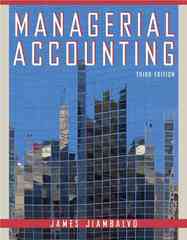Based on March's results, Byrce decided to meet with Kim Breashears, manager of the Phone Division and Jacob Carder, divisional controller. A partial transcript of their conversation is provided below:
Bryce: "March's profit performance is down once again, and I think we need to see if we can identify the problem and correct it-before it's too late. Kim, what's your assessment of the situation?"
Kim: "Foreign competition is eating us alive-selling phones at a lower price and high quality. If we could lower our prices by 10 to 15 percent, I think that we'd regain most of our lost market share. But we also need to make sure that the quality of our products meets that of our competitors. We are spending a lot of money each month on inspection, rework and warranties. I'd like to see these costs cost cut by 70 to 80 percent. If we could do that by improving quality, then customers would be more satisfied with our products, and we would not only regain our market share but increase it."
Jacob: "Kim, you mention reducing the costs of inspection, reworking, and warranties. For the inspection activity, we have 15 inspectors who are paid an average of $4,000 per month. Each inspector offers about 160 hours of inspection capacity per month. However, it appears inspectors actually work only about 80 percent of those hours. Rework cost is simply the cost of replacing some faulty components and the associated direct labor. The rework cost per unit is predictable and constant per unit regardless of the product model. Warranty cost, on the other hand, involves the salaries of two technicians, with the remaining cost the cost of replacement components, which is relatively constant per unit repaired. The technicians are paid $5,000 per month and provide 2,000 hours of service per year. Warranty service usually requires 3,600 technician hours per year."
Bryce: "Interesting. I wonder what the effect would have been on March's income if quality had improved to the point where demand for these activities was cut in half."
7 X http://east.cengagenow.com/ilrn/TakeAssignment/takeAssignmemMain.do?invoker=assignmen D ' 0 .My Blackb... \"Homework... Cengag... X {E 3:? 93} _ i _ r . r 2. 0 Step 1 Check My Work (3 remaining) if . A 3 0 Costs Concepts and Cost Behavior Instructions: Use the tabs above to navigate back and forth between steps. Learn how cost behavior can be used to identify opportun s to improve profita + Click here to refer to the question information. Based on March's results, Byrce decided to meet with Kim Breashears, manager of the Phone Division and Jacob Carder, divisional controller. A partial transcript of their conversation is provided below: Bryce: "March's prot performance is down once again, and I think we need to see if we can identify the problem and correri itebefore it's too late. Kim, what's your assessment of the situation?" Kim: "Foreign competition is eating us aliveiselling phones at a lower price and high quality. If we could lower our prices by 10 to 15 percent, I think that we'd regain most of our lost market share. But we also need to make sure that the quality of our products meets that of our competitors. We are spending a lot of money each month on inspection, rework and warranties. I'd like to see these costs cost cut by 70 to 80 percent. If we could do that by improving quality, then customers would be more satised with our products, and we would not only regain our market share but increase it." Jacob: "Kim, you mention reducing the costs of inspection, reworking, and warranties. For the inspection activity, we have 15 inspectors who are paid an average of $4,000 per month. Each inspector offers about 160 hours of inspection capacity per month. However, it appears inspectors actually work only about 80 percent of those hours. Rework cost is simply the cost of replacing some faulty components and the associated direct labor. The rework cost per unit is predictable and constant per unit regardless ofthe product model. Warranty cost, on the other hand, involves the salaries of two technicians, with the remaining cost the cost of repiacement components, which is relatively constant per unit repaired. The technicians are paid $5,000 per month and provide 2,000 hours of service per year. Warranty service usually requires 3,600 technician hours per year." Bryce: "Interesting. I wonder what the effect would have been on March's income if quality had improved to the point where demand for these activities was cut in half.\" Required: 1. Inspection is a cost, with each being dened by inspection hours per year. Each costs $ . Current activity capacity is hours. Current demand for the inspection activity is hours. cost. 2. Rework is a , Select your answer , X :1 http://east.cengagenow.corn/i|rn/TakeAssignment/takeAssignmentMain.do?invoker=assignmen D ' 0 .My Blackb... \"Homework... Cengag... X {E 3:? {:3} ,R 4. Assume that quality improves so that the demand for the output of the inspection, rework, and warranty activities drops by 50 percent (with the company capturing all savings possible i \\u A by reducing the resources currently used by the activities). a. Calcuiate the increase in March's preatax operating income produced by the savings for the following three activities: Savings: From inspection From rework me warranty Total b. What is the percentage of sales represented by the new operating income (round percentage to nearest tenth)? Operating income/Sales = % Summary Questions: 1. Inspection hours is a driver. 2. if demand for inspection drops by 50 percent, the new demand is inspection hours and unused capacity is hours. Thus, steps can be saved which produces annual savings of $ 3. Savings from inspection reduces . 4. Savings from rework reduces . 5. Savings from warranty reduces . Check My Work (3 remaining) V 05151"!sz








